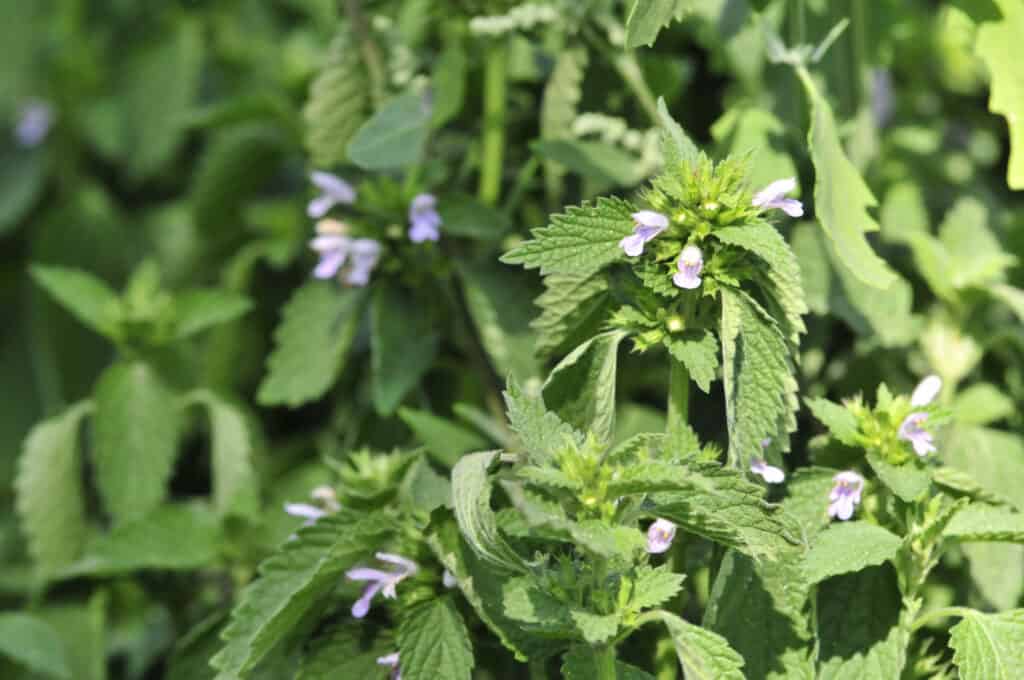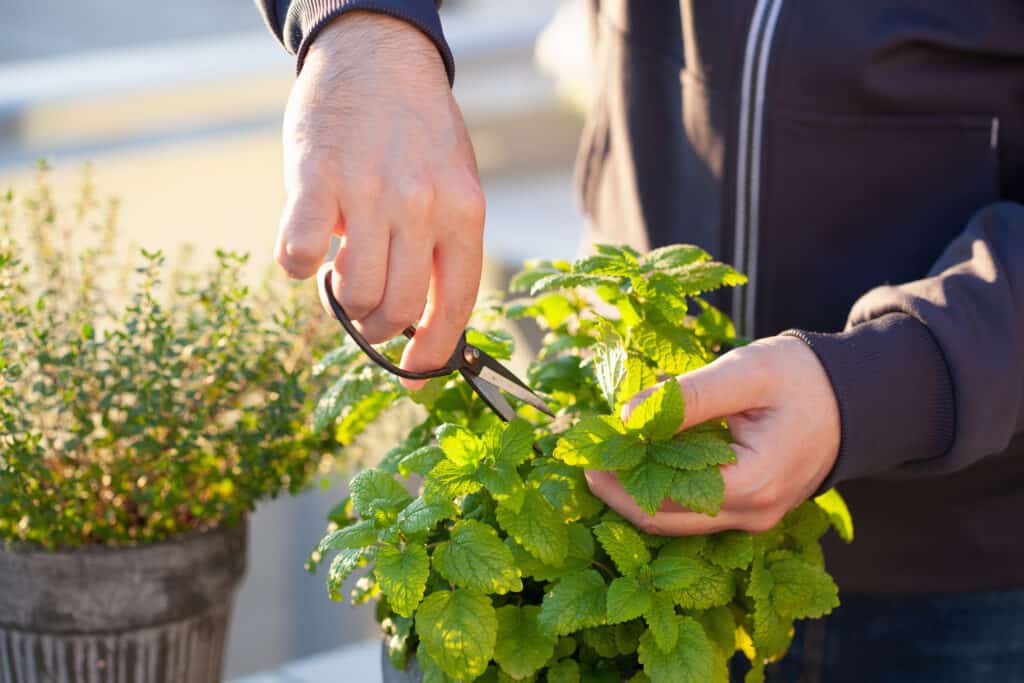Do you love scented plants and the gentle hum of bees? Look no further than citrusy lemon balm. This knockout herb is used in everything from toothpaste to medicine. English Tudor gardeners used lemon balm in the 1600s to keep their honeybee hives happy, but is lemon balm perennial or annual and how do you grow it? Let’s find out more.
Lemon Balm: Perennial or Annual

Lemon balm (
Melissa officinalis), common balm, or balm mint, is a perennial herbaceous plant in the mint family Lamiaceae.
©iStock.com/petrovaliliya
Lemon balm is a perennial that grows back each year. Annual plants die after one season (bedding plants are usually annuals), but lemon balm will re-emerge in spring even if it has died back to almost nothing. It’s hardy enough to grow in zones 3 and above in the United States.
What Is Lemon Balm?
Lemon balm (Melissa officinalis) is a member of the Lamiaceae family of mints that have aromatic foliage and fleshy stems. It has a myriad of names including English balm, honey plant, heart’s delight, Melissa, sweet balm, and balm mint.
On top of this, there are numerous variegated and compact cultivars. Lemon balm cultivars may be a little less robust than common lemon balm, but they are also perennials not annuals.
Lemon balm is native to Central Asia, Iran, The Mediterranean, and south-central Europe, but it’s a hardy perennial plant, so it’s naturalized in other areas including northern Europe and the Americas.
Its most recognizable feature is its lemon-scented foliage, similar to that of lemongrass, that is used widely in teas, culinary dishes, and commercially for its essential oil. Lemon balm can reach over three feet tall in a warm climate but tends to stop at one foot in temperate zones.
Its three-inch long scented leaves are heart-shaped, hairy, and prolific enough to create a bushy herb that’s attractive in ornamental gardens. Bees love its small white or pale purple flowers that grow atop a spike over the foliage.
Historical Uses Of Lemon Balm

Often used in teas, culinary dishes and distilled into essential oil, lemon balm has been utilized in food and medicine for thousands of years.
©iStock.com/Madeleine_Steinbach
Lemon balm has been used to flavor food and turned into medicines for thousands of years. The ancient Greeks and Romans called it honey leaf and used it heal wounds and freshen breath.
It traveled to medieval Europe in the 7th century and the famous herbalist Nicolas Culpepper described it soothed stomach ache, poor digestion, and ‘brain obstructions’. Henry 8th’s Tudor court used lemon balm to scent floors and keep honeybees happily foraging near their hives.
Lemon balm arrived in America with the first settlers and was grown in the Gardens of Monticello by Thomas Jefferson.
Lemon balm has a long association with humans. Today it’s used as a flavoring in toothpaste and its essential oil is extracted intensively for medicines and cleaning products. Lemon balm is also under the microscope for potential anti-anxiety properties.
Can Lemon Balm Survive Winter
Yes, lemon balm can survive winter. It’s a hardy perennial herb, not an annual, in zones 3 and above. In areas that freeze, lemon balm will die back to its roots and re-emerge in spring, but in warm zones, it retains its foliage and grows all year-round.
If you have a lemon balm that looks shriveled and dead in winter, don’t throw it away. When the warmer weather rolls round it will re-grow from the crown’s center.
But beware! Lemon balm will die if its roots are soggy. It likes well-drained soil and plenty of sunshine like other members of the Lamiaceae family such as basil and mint.
Does Lemon Balm Spread?
Lemon balm does have a tendency to spread, although sprawl is a better description! Lemon balm reaches around one foot in spread, but it’s a prolific seeder, so you may find seedling lemon balms spread around the garden.
If seedlings are in the wrong place, just dig them up. In a pot of damp compost, they will grow swiftly into full-sized plants. A pot of lemon balm on the windowsill is a lot easier to use than one growing outside!
Does Lemon Balm Repel Mosquitoes?

While not the most effective repellent, lemon balm contains citronellal and may help keep mosquitos away.
©iStock.com/nechaev-kon
It isn’t the most effective mosquito repellent, but lemon does contain citronellal which is similar to citronella. There’s no scientific proof it scares off mozzies, but anecdotal stories suggest a handful of crushed lemon balm does indeed keep pests away.
Some gardeners say growing lemon balm near fruit and vegetables help ward off aphids. Again, there’s no scientific proof, but it’s worth a try. At the very least it will attract bees that will pollinate your crops.
Is Lemon Balm Toxic To Dogs?
No, lemon balm is not toxic to dogs. The ASPCA says it’s a safe plant for dogs, cats, and horses, but it’s never a good idea to let pets chew on garden plants.
Should I Cut Back Lemon Balm?
In colder zones lemon balm will die back naturally, but if it’s perennially green it can look straggly and unkempt come winter. Cut lemon balm down to a few inches and fresh new growth will emerge.
Growing Lemon Balm

Lemon balm is a great option for container gardening.
©iStock.com/OlgaMiltsova
Lemon balm needs well drained soil and sun to partial sun. In its natural habitats, lemon balm is a sun lover, so give it plenty of warmth and light (at least 5 hours a day) for the strongest scent and most flowers.
This is also a great herb for a pot. Most Mediterranean herbs enjoy container life because they are generally drier and warmer there. Make sure the pot has lots of drainage and stand it on bricks to make sure excess water can run off. Soggy roots equal a dead lemon balm.
How To Take Lemon Balm Cuttings
Want to increase your lemon balm stock? Good idea – you can never have enough! The simplest way to propagate it is by cuttings. Snip off a piece of stem, around 3-4 inches long, just above a set of leaves.
Place this in a glass of water and after a week or two, you’ll see new white roots. when the roots appear, pop the new plants into well-drained, gritty compost to grow on. Be sure to keep lemon balm babies warm and gently watered.
Harvesting Lemon Balm
Lemon balm is delicious in fish dishes and soothing teas at home, so it’s a good idea to learn how to harvest it!
The good news is lemon balm is very forgiving and easy to pick. Simply pluck off leaves as you need them, but don’t take more than 1/3 of its foliage at one time. Lemon balm needs some greenery to regenerate. If you need just a few leaves, pinch out the top because this creates a bushier plant.
Don’t take leaves that have powdery mildew or mould. Pinch them off and give the plant a deep watering. If the leaves are a bit yellow, it will benefit from weak fertilizer.
If you have any lemon balm leaves left over, spread them on a kitchen towel to dry them out. Their flavor isn’t quite as pungent when they’re dried, but it’s still delicious and amazing in winter if your fresh lemon balm has died back.
Cool Facts About Lemon Balm
- Bees love lemon balm so much it’s named after them – Melissa is Greek for honeybee
- A lemon balm plant can live for 10 years
- It was officially named and recorded in 1753
- In ancient Iran lemon balm was used to treat scorpion stings
- Preliminary studies suggest lemon balm aids insomnia. In medieval times, lemon balm was put beneath pillows to promote good sleep. Our medieval ancestors were on to something!
Lemon Balm Is Perennial Not Annual
Perennial lemon balm will grow back year after year, so it’s not an annual. In cold areas that experience frosts lemon balm might die back all the way to its roots, but don’t worry. If the ground is well drained it will emerge again in spring with its fresh citrusy scent.
Up Next
The photo featured at the top of this post is © iStock.com/Nikolay_Donetsk
Sources
- Royal Botanical Gardens, Available here: https://powo.science.kew.org/taxon/urn:lsid:ipni.org:names:450084-1
- Phytotherapy Research, Available here: https://onlinelibrary.wiley.com/doi/10.1002/ptr.7252
- USDA, Available here: https://planthardiness.ars.usda.gov/
- ASPCA, Available here: https://www.aspca.org/pet-care/animal-poison-control/toxic-and-non-toxic-plants/lemon-balm
Thank you for reading! Have some feedback for us? Contact the AZ Animals editorial team.






